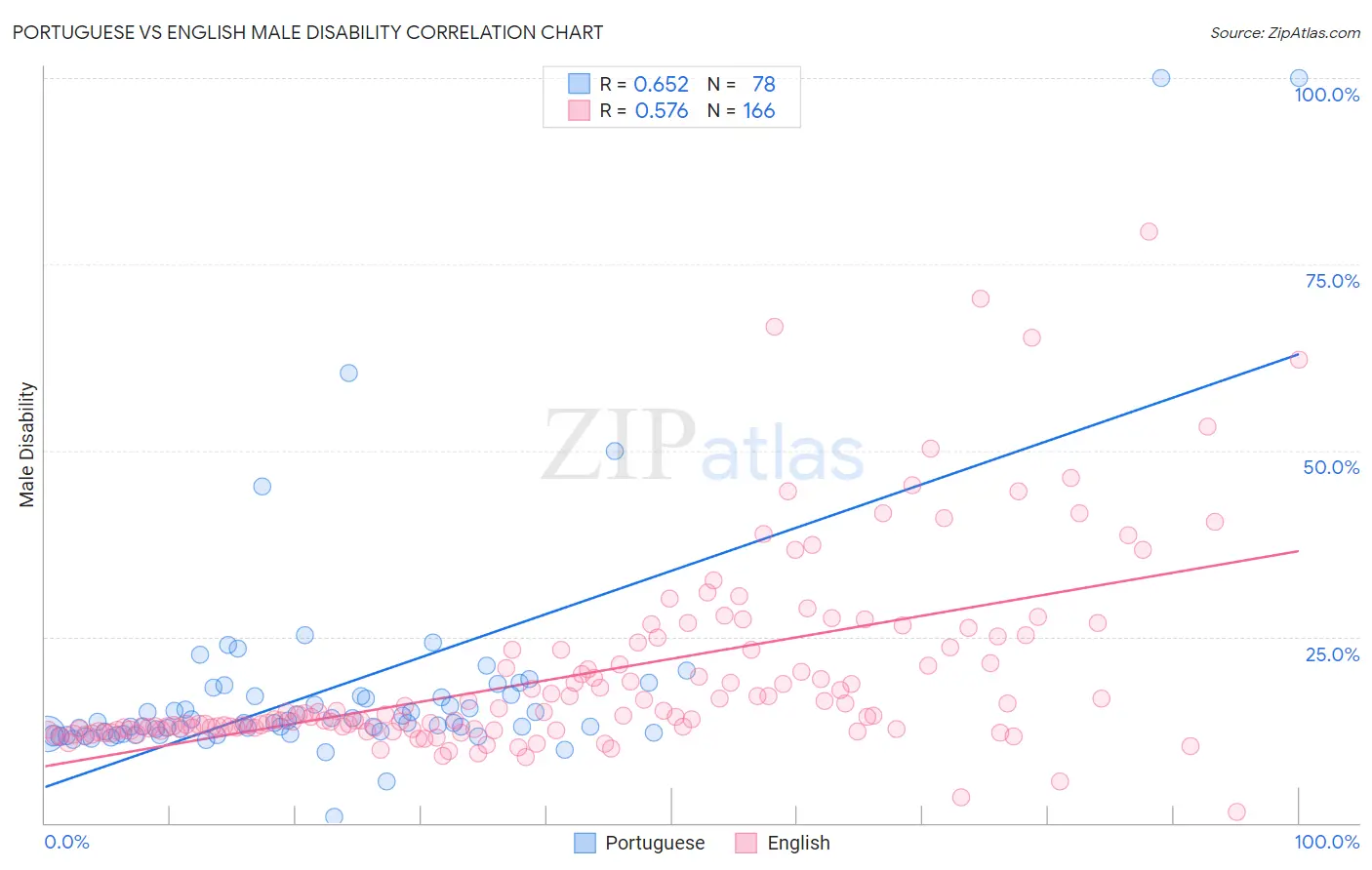Portuguese vs English Male Disability
COMPARE
Portuguese
English
Male Disability
Male Disability Comparison
Portuguese
English
12.3%
MALE DISABILITY
0.1/ 100
METRIC RATING
268th/ 347
METRIC RANK
12.8%
MALE DISABILITY
0.0/ 100
METRIC RATING
292nd/ 347
METRIC RANK
Portuguese vs English Male Disability Correlation Chart
The statistical analysis conducted on geographies consisting of 450,223,717 people shows a significant positive correlation between the proportion of Portuguese and percentage of males with a disability in the United States with a correlation coefficient (R) of 0.652 and weighted average of 12.3%. Similarly, the statistical analysis conducted on geographies consisting of 579,503,063 people shows a substantial positive correlation between the proportion of English and percentage of males with a disability in the United States with a correlation coefficient (R) of 0.576 and weighted average of 12.8%, a difference of 4.6%.

Male Disability Correlation Summary
| Measurement | Portuguese | English |
| Minimum | 0.74% | 1.4% |
| Maximum | 100.0% | 79.4% |
| Range | 99.3% | 78.0% |
| Mean | 18.0% | 19.9% |
| Median | 13.5% | 14.4% |
| Interquartile 25% (IQ1) | 12.0% | 12.6% |
| Interquartile 75% (IQ3) | 17.1% | 23.2% |
| Interquartile Range (IQR) | 5.1% | 10.6% |
| Standard Deviation (Sample) | 15.8% | 12.8% |
| Standard Deviation (Population) | 15.7% | 12.8% |
Similar Demographics by Male Disability
Demographics Similar to Portuguese by Male Disability
In terms of male disability, the demographic groups most similar to Portuguese are Czechoslovakian (12.3%, a difference of 0.0%), Spaniard (12.3%, a difference of 0.090%), Immigrants from Germany (12.3%, a difference of 0.13%), Hawaiian (12.3%, a difference of 0.18%), and Immigrants from Portugal (12.3%, a difference of 0.19%).
| Demographics | Rating | Rank | Male Disability |
| Slavs | 0.2 /100 | #261 | Tragic 12.2% |
| Norwegians | 0.2 /100 | #262 | Tragic 12.2% |
| Canadians | 0.2 /100 | #263 | Tragic 12.2% |
| Nepalese | 0.2 /100 | #264 | Tragic 12.2% |
| Immigrants | Portugal | 0.1 /100 | #265 | Tragic 12.3% |
| Hawaiians | 0.1 /100 | #266 | Tragic 12.3% |
| Immigrants | Germany | 0.1 /100 | #267 | Tragic 12.3% |
| Portuguese | 0.1 /100 | #268 | Tragic 12.3% |
| Czechoslovakians | 0.1 /100 | #269 | Tragic 12.3% |
| Spaniards | 0.1 /100 | #270 | Tragic 12.3% |
| Scandinavians | 0.1 /100 | #271 | Tragic 12.3% |
| Hmong | 0.0 /100 | #272 | Tragic 12.5% |
| Native Hawaiians | 0.0 /100 | #273 | Tragic 12.5% |
| Hopi | 0.0 /100 | #274 | Tragic 12.5% |
| Fijians | 0.0 /100 | #275 | Tragic 12.6% |
Demographics Similar to English by Male Disability
In terms of male disability, the demographic groups most similar to English are White/Caucasian (12.8%, a difference of 0.060%), Pima (12.8%, a difference of 0.15%), Yaqui (12.9%, a difference of 0.29%), Immigrants from Cabo Verde (12.8%, a difference of 0.30%), and Yup'ik (12.8%, a difference of 0.49%).
| Demographics | Rating | Rank | Male Disability |
| Welsh | 0.0 /100 | #285 | Tragic 12.7% |
| Scottish | 0.0 /100 | #286 | Tragic 12.8% |
| Cape Verdeans | 0.0 /100 | #287 | Tragic 12.8% |
| Yup'ik | 0.0 /100 | #288 | Tragic 12.8% |
| Immigrants | Cabo Verde | 0.0 /100 | #289 | Tragic 12.8% |
| Pima | 0.0 /100 | #290 | Tragic 12.8% |
| Whites/Caucasians | 0.0 /100 | #291 | Tragic 12.8% |
| English | 0.0 /100 | #292 | Tragic 12.8% |
| Yaqui | 0.0 /100 | #293 | Tragic 12.9% |
| Marshallese | 0.0 /100 | #294 | Tragic 12.9% |
| Immigrants | Micronesia | 0.0 /100 | #295 | Tragic 12.9% |
| Immigrants | Nonimmigrants | 0.0 /100 | #296 | Tragic 12.9% |
| Inupiat | 0.0 /100 | #297 | Tragic 13.0% |
| Pennsylvania Germans | 0.0 /100 | #298 | Tragic 13.0% |
| Celtics | 0.0 /100 | #299 | Tragic 13.0% |